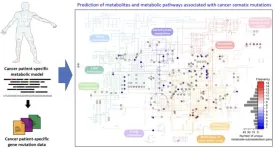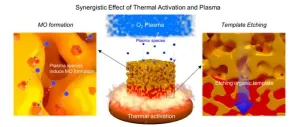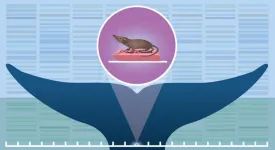(Press-News.org) We all know that getting a good night’s sleep is vital for physical and mental health. Yet many people share a bed with a partner who can’t help disturb their sleep. For example through their insomnia, frequently going to the bathroom, snoring, or a tendency to toss and turn in bed. Unsurprisingly, research has shown that poor sleep can lead to increased anger and decreased satisfaction with the relationship. But can we avoid falling in this trap, short of sleeping in separate bedrooms?
Yes, if we are naturally good – or learn to be so – at goal disengagement, the mental flexibility to jettison goals once they prove unachievable, suggests a new study in Frontiers in Psychology.
“Here we show that someone’s general capacity to let go of unattainable goals seems to prevent worsening satisfaction with their relationship, if their spouse experiences sleep problems,” said lead author Dr Meaghan Barlow, an assistant professor at Wilfrid Laurier University in Canada.
“This ability might allow such people to put more time and effort into their relationship and protect their spouse from blaming themselves.”
Replacing unattainable goals
Goal adjustment theory posits that people differ in their capacity to deal with goals in life that are temporarily or permanently unattainable through goal disengagement. This is the readiness to abandon such goals, and through goal reengagement, the tendency to look for easier goals to replace them. For example, someone who is unemployed might let go of the goal of finding their dream job in the immediate future, and then replace this with the goal of learning new skills to improve their attractiveness to employers.
Studies have shown that people who are better at doing this tend to report better subjective well-being. In contrast, being highly prone to goal reengagement can either lower or increase well-being, depending on whether the newly found goals are likely to overcome the problem at hand, without stretching personal resources too thin.
Sleeping couples
Barlow and colleagues investigated how such differences between individuals in their capacity for goal adjustment affects their ability to manage their partner’s sleep problems and stay satisfied with their relationship. They followed 113 cohabitating couples from the Montreal area over a period of one year.
They asked each spouse to answer questionnaires to measure relationship satisfaction, sleep efficiency, relationship-specific coping strategies, and goal adjustment capacity. The latter was measured with a tried-and-tested research tool, the 10-item goal adjustment ability survey, where respondents rate their agreement with statements like “It’s easy for me to reduce my effort towards the goal” or “I start working on other new goals”. Each questionnaire was administered twice, at the beginning and end of the study.
The results were statistically controlled for differences in age, education level, and family income. Gender was found not to affect the responses.
As expected, a greater general ability for coping with problems was associated with better relationship satisfaction, while couples where at least one partner reported feeling significant self-blame tended to experience less satisfaction with their relationship.
Vicious (sleep) cycle
Importantly, the results showed that the negative impact of poor partner sleep on relationship satisfaction was stronger for people with a low capacity for goal disengagement than for those with a high capacity.
“[These results suggest] that couples could enter a downward spiral, in which effects of poor sleep on relationship satisfaction result in a continued deterioration of quality of life … It may be possible for clinicians to prevent [this] by identifying couples with poor sleep and low levels of goal disengagement capacities … and working with them to redirect resources to the management of spousal stressors. Such interventions may foster effective coping with spousal stressors and contribute to well-being in romantic relationships,” wrote the authors.
For example, if your spouse experiences sleep problems, learning to become better at goal disengagement in general could help you to let go of less important goals, and reallocate those resources (eg, time and energy) towards protecting, maintaining, or even improving your relationship.
However, being highly prone to reengage with different goals may backfire, as has previously been shown for other contexts: the present results showed that the negative impact of poor partner sleep increased with greater goal reengagement capacity.
“Someone’s general capacity to find new goals when faced with an unattainable goal might put them at risk for worsening relationship satisfaction when they experience sleep problems, in part because it may cause them to put less time and effort into their relationship,” said Barlow.
“Future research should aim to first replicate these findings, and then seek to identify potential scalable intervention targets. I will be taking some of the lessons learned with me as I seek to develop scalable community interventions for the aging population in my local community,” concluded Barlow.
END
Is your partner’s disturbed sleep keeping you up at night? Letting go of unattainable dreams may keep you both happy in bed
Being ready to abandon unattainable goals prevents worse relationship satisfaction in couples experiencing sleep problems
2024-03-19
ELSE PRESS RELEASES FROM THIS DATE:
Molecular orientation is key: shining new light on electron behavior using 2-photon photoemission spectroscopy
2024-03-19
Osaka, Japan – Organic electronics is a field that has garnered significant interest in academic and industrial circles due to its potential applications in OLEDs and organic solar cells, offering advantages such as lightweight design, flexibility, and cost-efficiency. These devices are made by depositing a thin film of organic molecules onto a substrate that acts as an electrode, and function by controlling the transfer of electrons between the thin film and the substrate. Therefore, understanding electron behavior at the interface between the substrate ...
Continuous non-invasive glucose sensing on the horizon with the development of a new optical sensor.
2024-03-19
For decades, people with diabetes have relied on finger pricks to withdraw blood or adhesive microneedles to measure and manage their glucose levels. In addition to being painful, these methods can cause itching, inflammation and infection.
Researchers at TMOS, the Australian Research Council Centre of Excellence for Transformative Meta-Optical Systems, have taken an important step towards eliminating this discomfort. Their RMIT University team has discovered new aspects of glucose’s infrared signature and have used this information to develop a miniaturised optical sensor only 5mm in diameter that could one day be used to provide continuous non-invasive glucose monitoring in diabetes ...
Brain recordings in people before surgery reveal how all minds plan what to say prior to speaking
2024-03-19
A new study in people undergoing surgery to treat seizures related to epilepsy shows that pauses in speech reveal information about how people’s brains plan and produce speech.
Led by researchers at NYU Grossman School of Medicine, the study results add to evidence that neighboring brain regions, the inferior frontal gyrus and the motor cortex, play an important role in such planning before words are said aloud. Both are part of the folded top layers of the brain, or cerebral cortex, which has long been known to control the muscle (motor) movements in the throat and mouth needed to produce speech. Less ...
A KAIST-Seoul National University Hospital research team develops a computational workflow that predicts metabolites and metabolic pathways associated with somatic mutations in cancers
2024-03-19
Cancer is characterized by abnormal metabolic processes different from those of normal cells. Therefore, cancer metabolism has been extensively studied to develop effective diagnosis and treatment strategies. Notable achievements of cancer metabolism studies include the discovery of oncometabolites* and the approval of anticancer drugs by the U.S. Food and Drug Administration (FDA) that target enzymes associated with oncometabolites. Approved anticancer drugs such as ‘Tibsovo (active ingredient: ivosidenib)’ and ‘Idhifa (active ingredient: enasidenib)’ ...
Bendable energy storage materials by cool science
2024-03-19
Imaging being able to wear your smartphone on your wrist, not as a watch, but literally as a flexible band that surrounds around your arm. How about clothes that charge your gadgets just by wearing them? Recently, a collaborative team led by Professor Jin Kon Kim and Dr. Keon-Woo Kim of Pohang University of Science and Technology (POSTECH), Professor Taesung Kim and M.S./Ph.D. student Hyunho Seok of Sungkyunkwan University (SKKU), and Professor Hong Chul Moon of University of Seoul (UOS) has brought a step closer to making this realty. This research work was published in Advanced Materials.
Mesoporous ...
Inorganic nitrate can help protect patients against kidney damage caused during coronary angiographic procedures
2024-03-19
A five-day course of once-daily inorganic nitrate reduces the risk of a serious complication following a coronary angiogram, in which the dye used causes damage to the kidneys. The clinical trial, led by Queen Mary University of London and funded by Heart Research UK, also showed that the five-day course improves renal outcomes at three months and major adverse cardiac events (MACE) at one year compared to placebo.
Contrast-induced nephropathy (CIN), also known as contrast associated acute kidney injury (CA-AKI), is an uncommon but serious complication following ...
Active social lives help dementia patients, caregivers thrive
2024-03-19
EMBARGOED FOR RELEASE
6 p.m. PT / 9 p.m. ET, March 18, 2024
To coincide with publication in The Gerontologist
Media Contact: Suzanne Leigh (415) 680-5133
Suzanne.Leigh@UCSF.edu
Subscribe to UCSF News
People with dementia and those who care for them should be screened for loneliness, so providers can find ways to keep them socially connected, according to experts at UC San Francisco and Harvard, who made the recommendations after finding that both groups experienced declines in social well-being as the disease progressed.
The patients, whose ...
New technique measures psilocybin potency of mushrooms
2024-03-19
Since the 1970s, the federal government has listed the active ingredients in mushrooms—psilocybin and psilocin—as illegal and having no accepted medical use.
However, in recent years, medical professionals have found that these substances are safe and effective for treating stubborn conditions such as treatment-resistant depression and post-traumatic stress disorder. Some jurisdictions now allow for the medical use of mushrooms, while others are considering permitting or at least decriminalizing their recreational use.
Clinicians now find themselves needing to carefully ...
UC Irvine-led research team discovers role of key enzymes that drive cancer mutations
2024-03-19
Irvine, Calif., March 18, 2024 — A research team led by the University of California, Irvine has discovered the key role that the APOBEC3A and APOBEC3B enzymes play in driving cancer mutations by modifying the DNA in tumor genomes, offering potential new targets for intervention strategies.
The study, published today online in the journal Nature Communications, describes how the researchers identified the process by which APOBEC3A and APOBEC3B detect specific DNA structures, resulting in mutations at distinct positions within the tumor genome.
“It’s critical to understand how cancer cells accumulate mutations leading to ...
All creatures great and small: Sequencing the blue whale and Etruscan shrew genomes
2024-03-18
The blue whale genome was published in the journal Molecular Biology and Evolution, and the Etruscan shrew genome was published in the journal Scientific Data.
Research models using animal cell cultures can help navigate big biological questions, but these tools are only useful when following the right map.
“The genome is a blueprint of an organism,” says Yury Bukhman, first author of the published research and a computational biologist in the Ron Stewart Computational Group at the Morgridge Institute, an independent research organization that works in affiliation with the University of Wisconsin–Madison in emerging fields ...
LAST 30 PRESS RELEASES:
Making lighter work of calculating fluid and heat flow
Normalizing blood sugar can halve heart attack risk
Lowering blood sugar cuts heart attack risk in people with prediabetes
Study links genetic variants to risk of blinding eye disease in premature infants
Non-opioid ‘pain sponge’ therapy halts cartilage degeneration and relieves chronic pain
AI can pick up cultural values by mimicking how kids learn
China’s ecological redlines offer fast track to 30 x 30 global conservation goal
Invisible indoor threats: emerging household contaminants and their growing risks to human health
Adding antibody treatment to chemo boosts outcomes for children with rare cancer
Germline pathogenic variants among women without a history of breast cancer
Tanning beds triple melanoma risk, potentially causing broad DNA damage
Unique bond identified as key to viral infection speed
Indoor tanning makes youthful skin much older on a genetic level
Mouse model sheds new light on the causes and potential solutions to human GI problems linked to muscular dystrophy
The Journal of Nuclear Medicine ahead-of-print tip sheet: December 12, 2025
Smarter tools for peering into the microscopic world
Applications open for funding to conduct research in the Kinsey Institute archives
Global measure underestimates the severity of food insecurity
Child survivors of critical illness are missing out on timely follow up care
Risk-based vs annual breast cancer screening / the WISDOM randomized clinical trial
University of Toronto launches Electric Vehicle Innovation Ontario to accelerate advanced EV technologies and build Canada’s innovation advantage
Early relapse predicts poor outcomes in aggressive blood cancer
American College of Lifestyle Medicine applauds two CMS models aligned with lifestyle medicine practice and reimbursement
Clinical trial finds cannabis use not a barrier to quitting nicotine vaping
Supplemental nutrition assistance program policies and food insecurity
Switching immune cells to “night mode” could limit damage after a heart attack, study suggests
URI-based Global RIghts Project report spotlights continued troubling trends in worldwide inhumane treatment
Neutrophils are less aggressive at night, explaining why nighttime heart attacks cause less damage than daytime events
Menopausal hormone therapy may not pose breast cancer risk for women with BRCA mutations
Mobile health tool may improve quality of life for adolescent and young adult breast cancer survivors
[Press-News.org] Is your partner’s disturbed sleep keeping you up at night? Letting go of unattainable dreams may keep you both happy in bedBeing ready to abandon unattainable goals prevents worse relationship satisfaction in couples experiencing sleep problems





